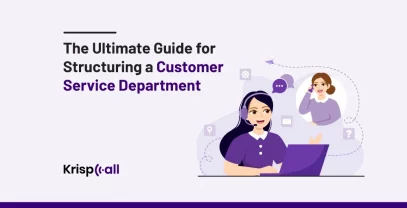As of now, for businesses, simply responding to customer issues as they occur is no longer adequate. That is because of the growing expectations of customers that also seem to change frequenlty.
And to get around that companies are increasingly implementing various support strategies to foresee and address potential problems before they worsen.
And among the many strategies, one is proactive support! But what exactly is proactive support?
In this article, we’ll discuss proactive support and also look at the many benefits of proactive support, and give you easy tips to make it work for your business.
Let’s get started!
🔑 KEY HIGHLIGHTS
- Proactive support is a strategic approach to anticipating and delivering on customers’ support needs before they ask for help.
- Implementing proactive customer support can significantly benefit both customers and businesses as it improves customer satisfaction, increases customer loyalty, lowers support costs, and enhances brand reputation.
- Proactive customer support can significantly reduce the number of support tickets and calls by preventing issues before they escalate.
- Proactive support can include contacting customers with helpful information, performing regular system checks, and monitoring for potential problems impacting customer satisfaction.
What is proactive support?
Proactive support is a customer service strategy emphasizing preemptive measures to anticipate and address potential issues before they affect customers. Unlike reactive support, which responds to problems after they have already impacted users, proactive support aims to be one step ahead by actively monitoring systems, identifying early warning signs, and taking corrective actions proactively. This approach prevents service disruptions and enhances overall customer satisfaction and loyalty.
One of the fundamental aspects of proactive support is monitoring tools and analytics to track customer behavior and system performance. By analyzing data trends and patterns, support teams can predict when and where issues might occur and intervene before customers are affected. This could involve proactive maintenance, updates, or even contacting customers with helpful tips and resources to optimize their experience.
Moreover, proactive support involves educating customers about potential challenges and providing them with the knowledge and tools to resolve issues independently. This is one of many customer service examples that fosters a proactive mindset among customers as they become more aware of how to prevent and handle common issues, making them feel more confident and in control.
Why should you provide proactive customer support?
Implementing proactive customer support can significantly benefit both customers and businesses. For customers, it demonstrates that the company values their experience and is committed to their satisfaction. This proactive stance can increase trust and loyalty, as customers feel more secure and appreciated.
For businesses, it means fewer incoming support tickets and a more efficient use of resources. Additionally, proactive support can provide valuable insights into everyday issues or areas for improvement, leading to better products and services in the long run.
That aside, here are five reasons why you (as a business owner) should provide proactive customer support:
1. Boosts Customer Satisfaction
Proactive support means reaching out to customers before they even realize a problem. Imagine getting a notification about a potential issue with your service, and the solution is already on its way.
This kind of attention to detail shows customers that you care about their experience and are committed to keeping things running smoothly for them. Happy customers will likely stay longer and spend more as they feel valued and well-taken care of which as a whole improves customer satisfaction.
2. Increases Customer Loyalty
When customers know a company is actively looking for them, it builds trust and loyalty. They feel more connected to the brand, knowing it’s not just about selling a product but ensuring ongoing satisfaction. This emotional connection can turn customers into brand advocates more likely to recommend your services to others, driving new business through word-of-mouth.
3. Lowers Support Costs
Proactive customer support can significantly reduce the number of support tickets and calls by preventing issues before they escalate. Your support team can focus on more critical or complex problems, improving efficiency. Fewer incoming issues mean less strain on your resources, ultimately saving your company money while maintaining high service standards.
4. Provides Valuable Insights
When you proactively address customer issues, you gain valuable data about everyday problems and potential areas of improvement. This information can be feedback into product development, helping you enhance your offerings and fix recurring issues.
It’s a continuous improvement cycle that benefits your business and customers, leading to better products and services over time.
5. Enhances Brand Reputation
A company known for its proactive customer support can build a strong, positive reputation in the market. Customers and potential clients see you as reliable and customer-focused, setting you apart from competitors.
This strong reputation can attract new customers, retain existing ones, and even allow you to command higher prices because people trust that they’re getting superior service and support.
How To Deliver Proactive Customer Support?
To deliver proactive customer support effectively, businesses must integrate proactive strategies into their customer service approach. By anticipating customer needs and issues, companies can enhance satisfaction and loyalty.
Here are eight practical ways that you can use to deliver proactive customer service:
1. Anticipate and Address Common Pain Points
Think about your customers’ problems and fix them before they happen. For example, if people often get confused about how to set up a product, make a simple instruction guide or video. This way, customers don’t have to contact you for help because they already have what they need.
2. Offer Personalized Support
Treat each customer like they are special. Use what you know about them to give advice that suits their needs. For example, if a customer buys a lot of art supplies, send them tips on new art techniques or special deals on new supplies. This hyper personalized customer experience makes customers feel valued and understood.
3. Conduct Regular Check-Ins
Reach out to your customers regularly to see how they are doing. After someone buys something, send a quick message to ask if they need help or if everything is going okay. This shows you care about their experience and want to ensure they are happy.
4. Provide Proactive Maintenance and Updates
Keep things running smoothly by updating and fixing problems before they become big. For example, if you have an app, send updates that improve how it works and fix bugs. This helps prevent problems from bothering your customers.
5. Offer Educational Resources
Help your customers by giving them guides and tutorials. This way, they can learn how to use your products better. For example, if you sell cameras, create videos that teach people how to take great photos. This not only helps them but also makes them appreciate your products more.
6. Monitor Social Media and Online Reviews
Watch what people say about you on social media and review sites. If someone has a problem or question, respond quickly. For example, if a customer tweets about an issue with your product, reply immediately to help them. This shows that you are paying attention and care about their experience.
7. Implement a Proactive Feedback Loop
Ask for feedback regularly and use it to improve your service. For example, send out surveys after a purchase and read the responses to see how to improve. This shows customers that you value their opinions and are always working to improve.
8. Use Data Analytics to Identify Trends and Patterns
Look at your data to see what your customers might need next. This helps you stay ahead of problems. For example, if data shows that many customers are looking for a specific feature, work on adding it to your product. This way, you can meet their needs before they even ask.
By implementing these proactive customer service strategies, businesses can build stronger customer relationships, reduce customer churn, and differentiate themselves in competitive markets. These approaches enhance customer satisfaction and contribute to long-term business success by fostering loyalty and advocacy.
Conclusion: Implement proactive customer support today
Delivering proactive customer support is about being human-centered and empathetic towards your customers’ needs, even before they reach out for help. By anticipating their concerns, offering personalized guidance, and maintaining open communication, you demonstrate that you genuinely care about their well-being.
Once you do that properly and effectively, customers perceive you are proactive and feel understood and appreciated, increasing loyalty and a higher likelihood of recommending your business to others.
This approach not only reduces the number of reactive support inquiries but also builds a stronger, more positive relationship with your customers. Don’t wait for issues to arise—take the initiative and transform your customer support today!
FAQs
What is a proactive support strategy?
A proactive support strategy is designed to anticipate and prevent customer issues rather than simply reacting to them. It involves identifying potential pain points, developing solutions, and implementing processes to avoid or mitigate problems before they arise.
What is a proactive approach?
A proactive approach is a mindset that involves taking the initiative to identify and address potential problems or opportunities rather than simply reacting to them. In customer service, a proactive approach involves anticipating and resolving customer issues before they become major problems.
What is a proactive service?
A proactive service is a type of customer service that anticipates and resolves customer issues before they become major problems. It involves providing timely and relevant customer support, often through automated or personalized means, to prevent or mitigate issues before they arise.
What is an example of being proactive?
An example of being proactive is a company that notifies customers about a potential issue with their account, such as a password reset or a payment processing error, before the customer realizes there’s a problem.
What are the benefits of proactive support?
The benefits of proactive support include:
- Improved customer satisfaction
- Reduced support requests
- Increased efficiency
- Enhanced customer trust
- Competitive advantage
- Cost savings





